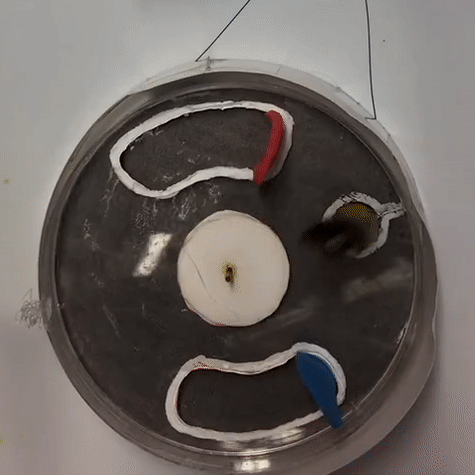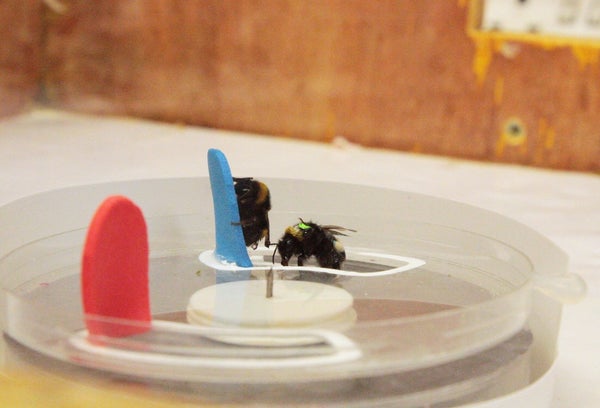Culture, at its most basic, refers to socially learned behaviors that are shared among a population. Until the mid-20th century, this ability was thought to be something uniquely human. But bountiful evidence now shows that culture exists in a wide variety of species, from bighorn sheep and vervet monkeys to meerkats and cranes.
Scientists are even discovering that insects can join in their own culture. In a new PLOS Biology study, researchers used a gold-standard test that’s been applied to species such as chimpanzees and great tits to reveal that bumblebees are capable of cultural transmission of information from one insect to another. Bees that were taught one of two solutions for opening a puzzle box spread that behavioral trait to untrained bees, creating a cultural signature for their colony. “This is an animal with a brain the size of a pinhead, and still they could achieve similar things [as] primates or birds, which is quite remarkable,” says lead author Alice Bridges, now a lecturer in biology and animal behavior at Anglia Ruskin University in England, who undertook the study as part of her doctoral research at Queen Mary University of London.

A bee opens a puzzle box by pushing against the red tab to rotate the lid of the box clockwise. Credit: Alice Bridges(CC-BY 4.0)
On supporting science journalism
If you're enjoying this article, consider supporting our award-winning journalism by subscribing. By purchasing a subscription you are helping to ensure the future of impactful stories about the discoveries and ideas shaping our world today.
Insects are known to be capable of social learning in the wild: the best-known example is the so-called waggle dance used by honeybees to communicate the location and quality of flowers. The new study builds on prior findings that bumblebees can learn complex behaviors in the lab, too, such as accessing rewards by pulling strings or rolling balls to play a sort of insect version of soccer. These earlier studies showed that bumblebees were capable of social learning but not necessarily of culture, which involves the spread of specific behaviors throughout a population. “We wanted to see whether the bees would be able to maintain a cultural tradition, even when there was an alternative behavior they could do,” Bridges says.
She and her colleagues adapted a puzzle box design that was previously used in experiments with primates and birds for their grape-sized study subjects. The bees could either push a red tab clockwise or a blue tab counterclockwise to access a sugar solution contained on a yellow target below. The researchers selected demonstrator bees from four colonies to teach others and trained half of these demonstrators to access the reward under the red tab and half to access it under the blue tab. Then the team put the bees back into their respective colonies, along with access to additional puzzle boxes.
As seen in other species, the researchers observed that the demonstrators proceeded to open the boxes in the way they had been taught and that a subset of those bees’ colony mates learned to do the same by watching them. Bumblebees, like people, have different personalities when it comes to work, from highly motivated to lazy, Bridges says, and bees in the former group tended to be the ones that learned the new behavior. Some go-getter individuals took just one day to begin mimicking the demonstrators’ behavior and solving the puzzle, whereas others took up to four days. On occasion, a bee would stumble on the solution for opening the other colored tab that the demonstrators in its colony hadn’t been taught to push. But the researchers found that this behavior would not stick and that those individuals would always go back to opening the tab that corresponded to their demonstrator bees’ behavior—that is, to their colony’s culture.
In two control colonies in which bees were trained to recognize the yellow target as signaling a reward but no demonstrators were trained to solve the puzzle, some individual insects did figure out how to open the box on their own. They were not as proficient as bees in experimental colonies that learned from demonstrators, however. Of the control bees that did figure this out, “most did it only a handful of times and then never again,” Bridges says. “So having the social learning element was critical to get the bees to actually permanently add box opening to their behavioral repertoire.”
This “exciting and groundbreaking study” takes the evidence that culture is widespread in the animal kingdom “to new levels,” says Andrew Whiten, a cognitive ethologist at the University of St Andrews in Scotland, who was not involved in the research. “The authors were coy in not venturing to put the word ‘culture’ in their title, but if it had been me, I would have had it there.”
Bridges suspects that other social insects such as honeybees and leaf cutter ants would show a similar capacity for culture. As scientists continue to add species to the list of those that demonstrate such capability, these new findings make a case, she says, that culture probably isn’t the “pinnacle of evolution” that humans have previously assumed it to be.
“Maybe culture is not something that is super exclusive or difficult,” Bridges says. “Maybe culture really is not all that.”
